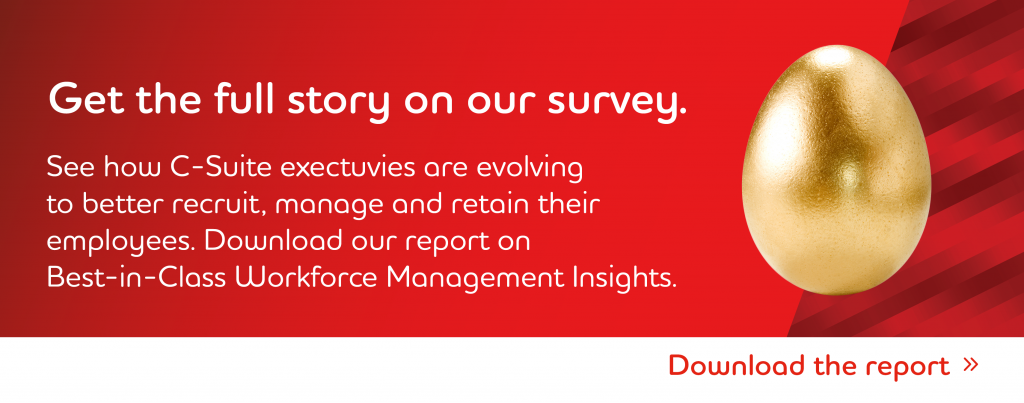
Wow. More than a third of companies do NOT use succession plans. You’re surprised, right? At least a little bit? Because, admittedly, we were. And even though we thought we knew the reasons for this shift, we were bound and determined to confirm our suspicions. So we did. And what we found was interesting—something you need to hear.
About that 34% stat
Let’s start with the source. It’s our hot-off-the-press (and must read) Best-in-Class Workforce Management Insights report, which is based on an Aberdeen Group and Adecco conducted survey of 500+ executives at leading companies. We picked their brains about how they’re managing their workforces. Things like wages and benefits and skill development and planning. That planning part is where we found this eye opening succession planning nugget.
The reasons why they’re not succession planning
At first, we kicked ourselves for not asking the survey recipients “why not?” But you can only ask so many questions. And we were so excited to conduct more research that it quickly became a moot point. Countless calls and conversations ensued. We chatted with our clients, our leaders and ourselves to pinpoint every reason succession planning is moving to the back burner. Here’s what we got.
- Companies are confident that the ambitious employees they hire are absorbing everything they can (particularly from their bosses) to prep themselves for the future.
- Organizations are gradually flattening their hierarchies in an effort to break down social, title-based barriers to communication and decision-making, triggering less inhibition about sharing proprietary knowledge.
- Millennials and Gen Zers, who are coming closer and closer to ruling the workforce, prefer fluidity and opportunity; they don’t want to be confined to rigid career paths, a.k.a., succession plans. (Learn more about these generations here.)
- Business moves at warp speed thanks to a mixture of controllable and uncontrollable economic and technological factors. This means businesses must be light on their feet and adapt on the fly; stale succession plans aren’t so conducive to adaptability.
Thoughts from our leader
Enter Lauren Griffin, Adecco USA’s Senior Vice President. She’s as savvy as they come in the staffing world—a workforce management maven. And here’s how she expounded upon the above reasons:
“Millennials are the largest generation in today’s workforce, and they see some things differently than their predecessors. For example, they don’t like to feel affixed to a career path. They value flexibility and options, which don’t necessarily align with succession planning.”
“Today’s workforce values immediate and regular feedback. They want to know how they’re doing, be recognized for their contributions and discuss what their next opportunities are. When hierarchies and succession plans take a back seat, the workplace tends to become more social—where feedback and conversations naturally occur.”
Lauren goes on…
“Although the game is changing, succession planning is not completely null and void; in fact, most companies are still implementing it. Some level of knowledge sharing, mentoring and passing the torch obviously must occur in order to prosper in the future.”
Why you should care
You manage a complex workforce. One with multiple generations, different departments, temps, full timers, etc. And generally, the better you manage your workforce, the more you increase retention and productivity and improve your bottom line. If over a third of the most successful, recognizable companies in America are dialing back formal succession planning, we should all pay attention. It’s yet another way workforce management is evolving for the better.
What you should do
It’d be unwise of us to direct you with a concrete order. But what we can do is offer you a few pieces of advice to steer you in the right direction.
A big decision. Deciding whether to succession plan—or not—is far from a one-size-fits-all decision. It’s unique to your business; it could even be unique to departments within your business. So, first, determine where structured information sharing and organized tutelage is necessary, and where it’s not.
Your hierarchy. That org chart that’s so important, but, ironically, rarely analyzed. Is it creating an intimidating, unbreakable structure? Is it stifling communication (and knowledge sharing) between layers? Study your hierarchy; more importantly, study the social effects of it and adjust accordingly.
The psychology. Millennials and Gen Zers see the world of work through a different lens—a modern, variable lens that lets them zoom in and out freely. Being an official successor locks that lens in place. Get to know your potential future leaders; understand how they prefer to learn and climb the ladder so you can keep them fulfilled.
For more on succession planning—and the most recent trends in workforce management—get your free copy of “Best-in-Class Workforce Management Insights.” Something tells us you’ll love it!

